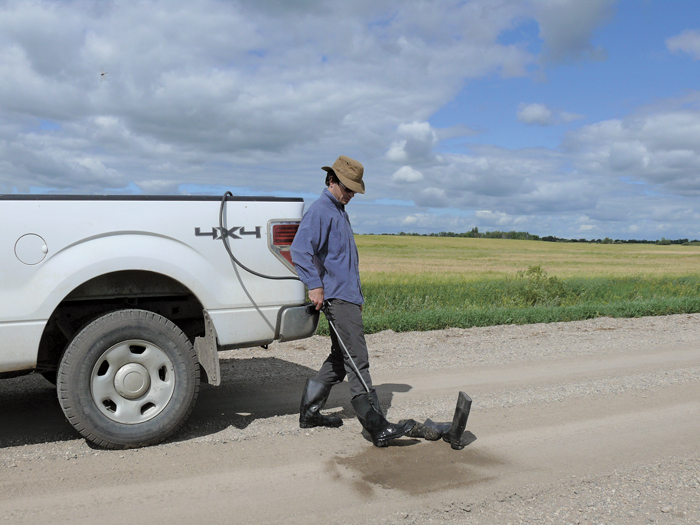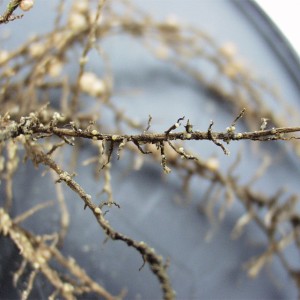The risk of devastating losses from potato pests can be managed through crop biosecurity measures, says Vikram Bisht, an extension plant pathologist for Manitoba Agriculture, Food and Rural Development.
As part of his presentation at Manitoba Potato Production Days in Brandon in January, Bisht issued a call to action to potato growers to stay ahead of the curve in implementing biosecurity management strategies on their farms.

Bisht says potato wart, potato cyst nematode, bacterial wilt (or brown rot) and bacterial ring rot are all diseases of concern to Manitoba potato growers in 2015. Manitoba pathologists are especially concerned about necrotic viruses and bacterial ring rot. For several years, Manitoba had been free of bacterial ring rot, but the disease has recently been discovered in the province.
Bisht says the slime of the bacteria is hard to eradicate once present on the farm — though the disease has a good chance of survival in live potato tissue, it can also survive for many years in dried “biofilms” on surfaces.
“It can dry on equipment, trucks, and walls of storages, so it survives for a long time, and the losses can be pretty severe.”
Read Also

Beekeepers want financial protection against tropi mite
Tropilaelaps (tropi) mites haven’t landed in Canada yet; beekeepers want to know they’ll get federal financial help if the deadly bee parasite ever does
Bacterial ring rot is a federally regulated disease for seed potato crops, which means that once discovered in a seed crop, the entire crop is written off for seed. “For a seed grower, it can be devastating. If confirmed by CFIA in one or two tests, the seed crop becomes a non-seed crop,” Bisht says.
And because seed potatoes and process potatoes are stored at different temperatures, non-seed potatoes aren’t easily sold even to pro-cessors.
Bioexclusion and biocontainment
Once the disease is confirmed on an operation the grower must clean and sanitize the entire operation in the presence of an inspector.
Farm-level biosecurity measures can help growers mitigate the risk posed by devastating diseases such as bacterial ring rot, Bisht says. Biosecurity measures fit into two categories: bioexclusion, which reduces the introduction of pests onto the farm, and biocontainment, which minimizes their spread.
A national farm-level biosecurity standard for potato growers has been developed by the Canadian Food Inspection Agency, Agriculture and Agri-Food Canada, the Canadian Potato Council, the Canadian Horticultural Council and the provincial Departments of Agriculture. It outlines proactive strategies for good biosecurity that growers can adapt for use on their own operations.
Key elements of good biosecurity include knowing the pests of concern in the area and identifying the pathways by which they spread, including water, soil, seed, air and common vectors. Boundaries should be protected with gates and signs, and biosecure zones should be marked.
At the beginning of the season, Bisht says, all equipment, storages and seed cutters should be thoroughly cleaned and disinfected. During the season, vehicles, equipment and shoes should be checked for soil residue between fields. Pesticides should be used as needed.
Cull piles are a significant source for disease inoculum development and spread, but they can be relatively easily — and inexpensively — managed. “I would emphasize the management of cull piles as an important biosecurity measure growers can take,” Bisht says.
In Manitoba, growers are ahead of the curve in implementing good biosecurity systems on their operations. “The greater the potential loss, the greater the need for biosecurity measures,” he says.
Canola and corn diseases can also affect potatoes
Grower-led Pest Surveillance Initiative with Canola Growers and MAFRD
MAFRD plant pathologist Vikram Bisht says potato growers should also be aware of important non-potato diseases that might affect other crops in the rotation, such as soybean cyst nematode, canola clubroot and verticillium wilt.
“Canola and corn and other crops are part of the rotation. The movement of soil with any crop can create issues for the other crops in rotation,” he says.
In Manitoba, a grower-led effort called the Pest Surveillance Initiative (PSI) is a recent joint project of the Manitoba Canola Growers Association and MAFRD, with funding from the Growing Actions plan of Growing Forward 2. PSI is focusing on developing technologies for the “molecular” detection of low levels of clubroot in the province.
This spring, sampling will resume for growers interested in testing fields for low levels of club-root bacteria.
“This is a very good initiative that will help our province,” says Bisht.
Support for integrated biosecurity measures at every level — from the farm to federal agencies — is crucial for success, Bisht says. Federal and provincial agencies, as well as researchers, agronomists and certified crop advisers must work together to minimize the spread of pests.
















